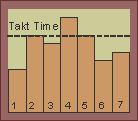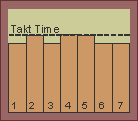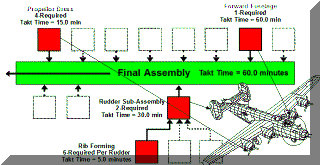All About Takt Time
Takt Time - Definition, Benefits, Uses and Limitations
What Is Takt Time?
Definition: Takt Time-- the desired time between units of production output, synchronized to customer demand. The concept carries backward through a process stream. Ideally, every step synchronizes with the final output. Takt Time is fundamental to Lean Manufacturing.
The figure illustrates the concept for the B-24 aircraft built at Willow Run during World War II. The final assembly rate was established at "a bomber an hour" so the Takt time for Final Assembly is 60.0 minutes.
- The aircraft requires one Forward Fuselage sub-assembly and the Takt time for this production area is also 60.0 minutes.
- Four propellers per aircraft generate a Takt time at Propeller Dress of 15.0 minutes.
- Each ship needs two rudders, so Takt time for Rudder Sub-Assembly is 30.0 minutes.
- Each rudder requires six ribs. Takt time for Rib Forming is, therefore, 5.0 minutes.
Benefits of Takt Time
The simplicity of the concept belies its extraordinary effects. Among these are:
Production Stability- by limiting overproduction, it stabilizes the system and prevents buildups of inventory and the subsequent stops and starts.
Workcell Design- Takt time helps cell designers. In an ideal workcell, all tasks are balanced, they all require the same time to execute and that time equals the Takt time. If any operation requires more than the Takt time, the cell cannot produce at the necessary rate.
In the first illustration, below the cell cannot make the necessary quantity because operation #4 exceeds the Takt time. In the second chart, the work has been balanced at Takt time or slightly below. This, however, is not the only way to balance workcells.


Psychological- immediate feedback of performance is a powerful motivator. When a workcell team tracks takt time, they have a heightened awareness of output rates and potential problems. They attempt to achieve the Takt time on each cycle and immediately make necessary corrections.
When Charles Sorensen conceived and built the Willow Run Bomber plant, he designed it for "A bomber an hour". He did not say "nineteen ships per day" or "120 per week." Sorensen understood the value of steady, repetitive output.
At one point in planning a subordinate asked Sorensen how they should schedule such a complex operation. "Cast Iron Charlie" shot back- "Your schedule is to build a bomber an hour!". The result was a very simple and effective scheduling system using broadcast and kanban. There were no computers in 1940.
History of Takt Time
Takt is a German word which refers to the beat of music. It can also mean cycle, rhythm or repetition time. Sometimes it refers to the baton of an orchestra leader.
During the 1930's, Germany and Japan were part of the Axis and German engineers helped organize the Japanese aircraft industry. They used the analogy of a conductor's baton setting rhythm for the entire orchestra. After the war, Toyota picked up the word and concept for its Just In Time or Toyota Production System.
Limitations of Takt Time
Takt time is useful for simple cells These are typical of the workcells at Toyota and what most people think of when they picture a cell. Such cells have:
- Minimal Setups
- A Single Routing
- Identical Work Times for All Products
Job-shops and other low-volume, high-variety operations can also use cellular manufacturing, it's just a bit more complicated. Takt time has little relevance for these Group Technology workcells.
Here we must account for setup times, multiple routings and varied work times. Mr. Lee's book, "Facilities and Workplace Design" shows how to do this. You may download the chapter on workcells from the upcoming Second Edition
Problems can result from an unjustified preoccupation with Takt time. Designers who think only of Takt time may conclude that certain products cannot use Cellular Manufacturing and their companies lose the many benefits.
In other situations, an obsession with Takt time, One Piece flow and linear cells leads to unsuitable designs. This can have disastrous results as shown in our page "When Kaizen Blitzing Replaces Strategy".
Takt time is a powerful and valuable concept. Like all intellectual constructs, it has limits.
■ ■ ■ ■ ■ ■ ■





